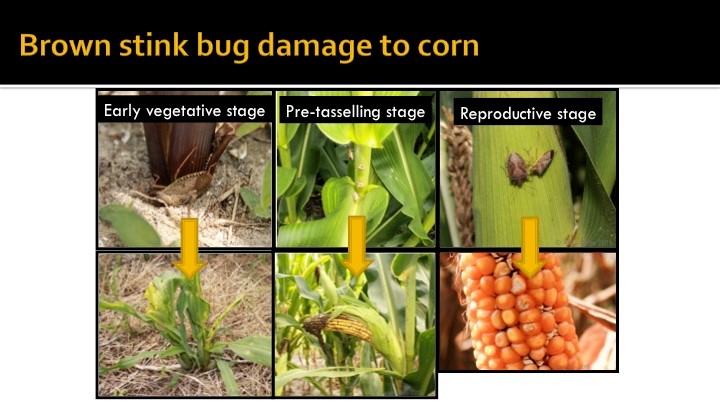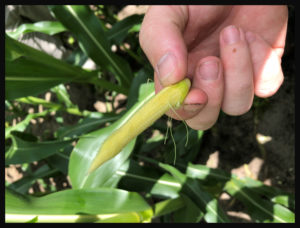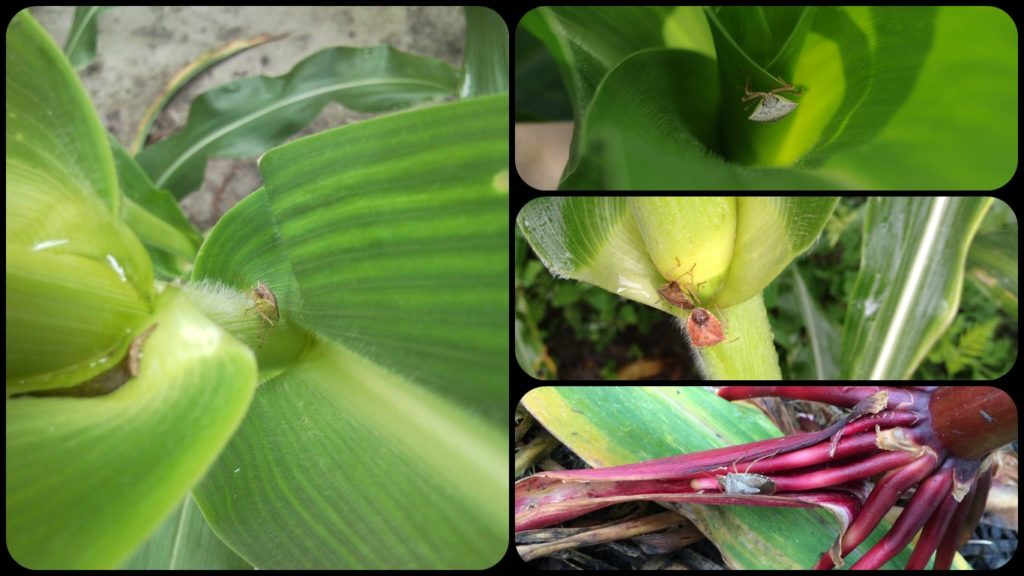Stink Bug Management in Corn
go.ncsu.edu/readext?575115
en Español / em Português
El inglés es el idioma de control de esta página. En la medida en que haya algún conflicto entre la traducción al inglés y la traducción, el inglés prevalece.
Al hacer clic en el enlace de traducción se activa un servicio de traducción gratuito para convertir la página al español. Al igual que con cualquier traducción por Internet, la conversión no es sensible al contexto y puede que no traduzca el texto en su significado original. NC State Extension no garantiza la exactitud del texto traducido. Por favor, tenga en cuenta que algunas aplicaciones y/o servicios pueden no funcionar como se espera cuando se traducen.
Português
Inglês é o idioma de controle desta página. Na medida que haja algum conflito entre o texto original em Inglês e a tradução, o Inglês prevalece.
Ao clicar no link de tradução, um serviço gratuito de tradução será ativado para converter a página para o Português. Como em qualquer tradução pela internet, a conversão não é sensivel ao contexto e pode não ocorrer a tradução para o significado orginal. O serviço de Extensão da Carolina do Norte (NC State Extension) não garante a exatidão do texto traduzido. Por favor, observe que algumas funções ou serviços podem não funcionar como esperado após a tradução.
English
English is the controlling language of this page. To the extent there is any conflict between the English text and the translation, English controls.
Clicking on the translation link activates a free translation service to convert the page to Spanish. As with any Internet translation, the conversion is not context-sensitive and may not translate the text to its original meaning. NC State Extension does not guarantee the accuracy of the translated text. Please note that some applications and/or services may not function as expected when translated.
Collapse ▲Dominic Reisig and Ron Heinger
Brown stink bug is the primary pest species of corn in North Carolina, although brown marmorated stink bug, green stink bug and southern green stink bug can also be pests. They feed through piercing sucking mouthparts and can cause three distinct types of damage.
- Early vegetative stages (V1 to V6)- plants can be stunted, yield-robbing tillers can be formed, or plants can be killed. This damage can easily be confused with billbug damage.
- Pre-tasselling stage (V14 to VT)- ears can be crooked (banana ear) and kernels can be missing. This damage can easily be confused with damage from moisture or nutrient stress.
- Reproductive stage (R1 to R4)- kernel size and weight can be reduced and secondary pathogens can be introduced that lead to aflatoxin or fumonisin contamination.
Where can stink bugs be a problem?
- Corn fields planted in no-till fields with heavy cover. Watch for feeding in open-furrows.
- Wheat-corn interfaces. Stink bugs aren’t a pest of wheat, but will feed on wheat up to the time of harvest. Wheat harvest can push stink bugs into nearby corn, but this isn’t a guarantee.
- Corn fields planted behind soybeans. Stink bugs build up in soybeans during the late summer and early fall after other crops are harvested. Check field edges near woods, where stink bugs may have overwintered after building up in last year’s soybeans.

You can peel back the leaf prior to tasseling at the nodes where the ears will form to find them pushing out.
Scouting. Consult the Stink Bug Scouting Guide for Field Corn in the Southeastern US. This is a complete in-depth resource on how to correctly scout stink bugs in corn. Information on stink bug identification can be found here.
Thresholds. Thresholds vary depending on growth stage and are based on a 100 plant sample as described below (see table). These thresholds are not percentages, but numbers. If a single plant has multiple stink bugs, this must be counted into the total. If the number of stink bugs exceeds the number in the “treat” category, treat the field even if 100 plants have not been sampled. If the number of stink bugs per plant falls between the “treat” and “do not treat” category, take more samples until a confident decision can be made.
| Growth stage |
Area to sample |
Do not treat |
Take more samples |
Treat |
| V1 to V6 | Base of plant on stalk below lowest green leaf | ≤6 | >7 to 12 | ≥13 |
| V14 to VT | Stalk from first leaf above and below primary ear | ≤4 | >5 to 9 | ≥10 |
| R1 to R2 | Stalk at one leaf above and two leaves below primary ear | ≤14 | >15 to 27 | ≥28 |
Alternatively, if the entire plant is sampled, thresholds are 1 per 10 plants (V1 to V6), 1 per 4 plants (V14 to VT), and 1 per 2 plants (R1 to R2).
Insecticide control. Many insecticides in the pyrethroid class are effective for brown stink bug in corn. However, bifenthrin is the most effective both because it can be applied at a rate that contains more active ingredient than other pyrethroids and because it is more toxic to brown stink bugs. Expect only a week residual.
Two critical factors to achieve control are:
- Coverage- deliver insecticide where the stink bugs are located (photo below). Ensure canopy penetration with proper nozzle, pressure and volume selection.
- Timing- the most critical time to treat from V14 to VT is just before the primary ear is exposed. Aim to control stink bugs when the primary ear is between these stages, but preferably on the early side to avoid banana ear.
Stink Bug Management in Corn (Printable version)





